您好,登錄后才能下訂單哦!
您好,登錄后才能下訂單哦!
這篇文章主要講解了“怎么使用Vue.js中的List Rendering”,文中的講解內容簡單清晰,易于學習與理解,下面請大家跟著小編的思路慢慢深入,一起來研究和學習“怎么使用Vue.js中的List Rendering”吧!
recap
這里先用幾張圖片回顧和整理下上一篇Vue.js源碼(1):Hello World的背后的內容,這將對本篇的compile,link和bind過程的理解有幫助:
copmile階段:主要是得到指令的descriptor
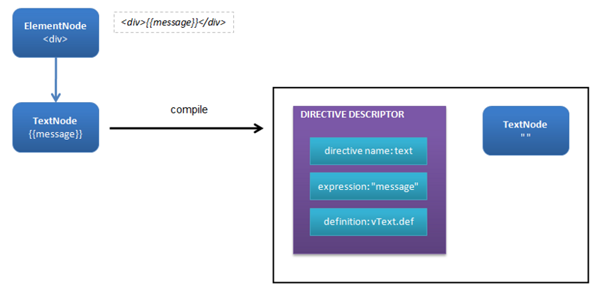
link階段:實例化指令,替換DOM
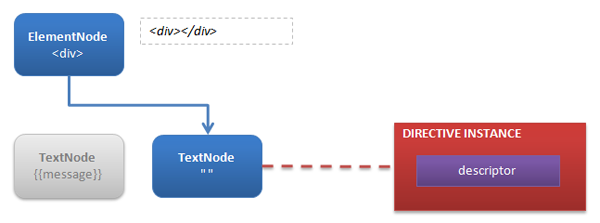
bind階段:調用指令的bind函數,創建watcher

用一張圖表示即為:
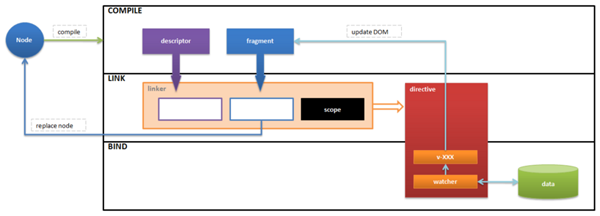
observe array
初始化中的merge options,proxy過程和Hello World的過程基本一樣,所以這里直接從observe開始分析。
// file path: src/observer/index.js var ob = new Observer(value) // value = data = {todos: [{message: 'Learn JavaScript'}, ...]}// file path: src/observer/index.js export function Observer (value) { this.value = value this.dep = new Dep() def(value, '__ob__', this) if (isArray(value)) { // 數組分支 var augment = hasProto ? protoAugment : copyAugment // 選擇增強方法 augment(value, arrayMethods, arrayKeys) // 增強數組 this.observeArray(value) } else { // plain object分支 this.walk(value) } }增強數組
增強(augment)數組,即對數組進行擴展,使其能detect change。這里面有兩個內容,一個是攔截數組的mutation methods(導致數組本身發生變化的方法),一個是提供兩個便利的方法$set和$remove。
攔截有兩個方法,如果瀏覽器實現__proto__那么就使用protoAugment,否則就使用copyAugment。
// file path: src/util/evn.js export const hasProto = '__proto__' in {} // file path: src/observer/index.js // 截取原型鏈 function protoAugment (target, src) { target.__proto__ = src } // file path: src/observer/index.js // 定義屬性 function copyAugment (target, src, keys) { for (var i = 0, l = keys.length; i < l; i++) { var key = keys[i] def(target, key, src[key]) } }為了更直觀,請看下面的示意圖:
增強之前:

通過原型鏈攔截:
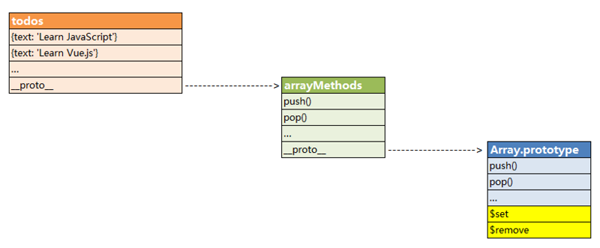
通過定義屬性攔截:
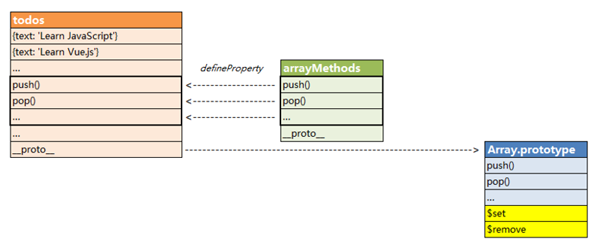
在攔截器arrayMethods里面,就是對這些mutation methods進行包裝:
調用原生的Array.prototype中的方法
檢查是否有新的值被插入(主要是push, unshift和splice方法)
如果有新值插入,observe它們
***就是notify change:調用observer的dep.notify()
代碼如下:
// file path: src/observer/array.js ;[ 'push', 'pop', 'shift', 'unshift', 'splice', 'sort', 'reverse' ] .forEach(function (method) { // cache original method var original = arrayProto[method] def(arrayMethods, method, function mutator () { // avoid leaking arguments: // http://jsperf.com/closure-with-arguments var i = arguments.length var args = new Array(i) while (i--) { args[i] = arguments[i] } var result = original.apply(this, args) var ob = this.__ob__ var inserted switch (method) { case 'push': inserted = args break case 'unshift': inserted = args break case 'splice': inserted = args.slice(2) break } if (inserted) ob.observeArray(inserted) // notify change ob.dep.notify() return result }) })observeArray()
知道上一篇的observe(),這里的observeArray()就很簡單了,即對數組對象都observe一遍,為各自對象生成Observer實例。
// file path: src/observer/index.js Observer.prototype.observeArray = function (items) { for (var i = 0, l = items.length; i < l; i++) { observe(items[i]) } }compile
在介紹v-for的compile之前,有必要回顧一下compile過程:compile是一個遞歸遍歷DOM tree的過程,這個過程對每個node進行指令類型,指令參數,表達式,過濾器等的解析。
遞歸過程大致如下:
compile當前node
如果當前node沒有terminal directive,則遍歷child node,分別對其compile node
如果當前node有terminal directive,則跳過其child node
這里有個terminal directive的概念,這個概念在Element Directive中提到過:
A big difference from normal directives is that element directives are terminal, which means once Vue encounters an element directive, it will completely skip that element
實際上自帶的directive中也有兩個terminal的directive,v-for和v-if(v-else)。
terminal directive
在源碼中找到:
terminal directive will have a terminal link function, which build a node link function for a terminal directive. A terminal link function terminates the current compilation recursion and handles compilation of the subtree in the directive.
也就是上面遞歸過程中描述的,有terminal directive的node在compile時,會跳過其child node的compile過程。而這些child node將由這個directive單獨compile(partial compile)。
以圖為例,紅色節點有terminal directive,compile時(綠線)將其子節點跳過:
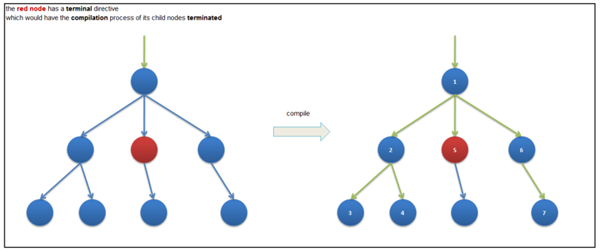
為什么是v-for和v-if?因為它們會帶來節點的增加或者刪除。
Compile的中間產物是directive的descriptor,也可能會創建directive來管理的document fragment。這些產物是在link階段時需要用來實例化directive的。從racap中的圖可以清楚的看到,compile過程產出了和link過程怎么使用的它們。那么現在看看v-for的情況:
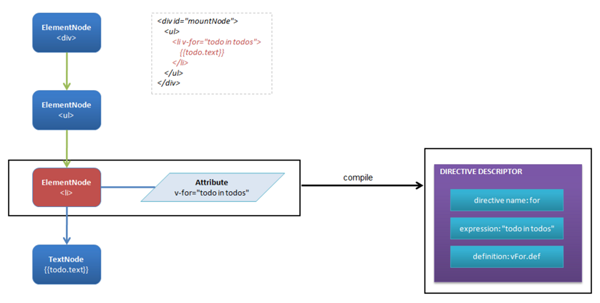
compile之后,只得到了v-for的descriptor,link時將用它實例化v-for指令。
descriptor = { name: 'for', attrName: 'v-for', expression: 'todo in todos', raw: 'todo in todos', def: vForDefinition }link
Hello World中,link會實例化指令,并將其與compile階段創建好的fragment(TextNode)進行綁定。但是本文例子中,可以看到compile過程沒有創建fragment。這里的link過程只實例化指令,其他過程將發生在v-for指令內部。
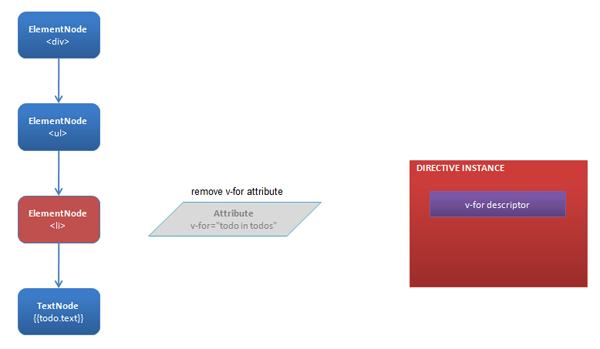
bind
主要的list rendering的魔法都在v-for里面,這里有FragmentFactory,partial compile還有diff算法(diff算法會在單獨的文章介紹)。
在v-for的bind()里面,做了三件事:
重新賦值expression,找出alias:"todo in todos"里面,todo是alias,todos才是真正的需要監聽的表達式
移除<li v-for="todo in todos">{{todo.text}}</li>元素,替換上start和end錨點(anchor)。錨點用來幫助插入最終的li節點
創建FragmentFactory:factory會compile被移除的li節點,得到并緩存linker,后面會用linker創建Fragment
// file path: /src/directives/public/for.js bind () { // 找出alias,賦值expression = "todos" var inMatch = this.expression.match(/(.*) (?:in|of) (.*)/) if (inMatch) { var itMatch = inMatch[1].match(/\((.*),(.*)\)/) if (itMatch) { this.iterator = itMatch[1].trim() this.alias = itMatch[2].trim() } else { this.alias = inMatch[1].trim() } this.expression = inMatch[2] } ... // 創建錨點,移除LI元素 this.start = createAnchor('v-for-start') this.end = createAnchor('v-for-end') replace(this.el, this.end) before(this.start, this.end) ... // 創建FragmentFactory this.factory = new FragmentFactory(this.vm, this.el) } 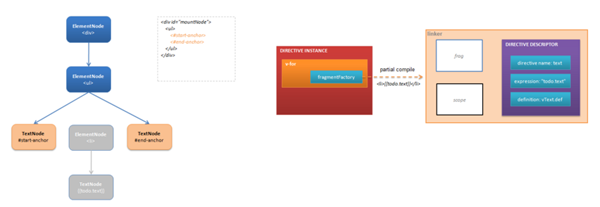
Fragment & FragmentFactory
這里的Fragment,指的不是DocumentFragment,而是Vue內部實現的一個類,源碼注釋解釋為:
Abstraction for a partially-compiled fragment. Can optionally compile content with a child scope.
FragmentFactory會compile<li>{{todo.text}}</li>,并保存返回的linker。在v-for中,數組發生變化時,將創建scope,克隆template,即<li>{{todo.text}}</li>,使用linker,實例化Fragment,然后掛在end錨點上。
在Fragment中調用linker時,就是link和bind<li>{{todo.text}}</li>,和Hello World中一樣,創建v-text實例,創建watcher。
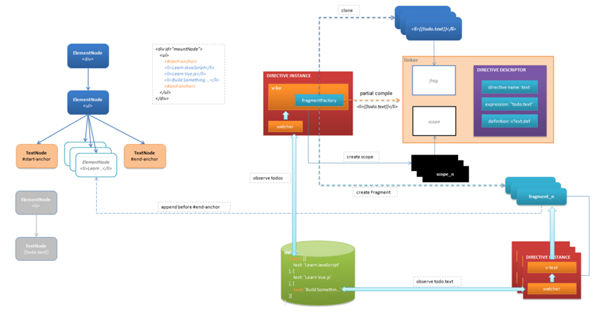
scope
為什么在v-for指令里面可以通過別名(alias)todo訪問循環變量?為什么有$index和$key這樣的特殊變量?因為使用了child scope。
還記得Hello World中watcher是怎么識別simplePath的嗎?
var getter = new Function('scope', 'return scope.message;')在這里,說白了就是訪問scope對象的todo,$index或者$key屬性。在v-for指令里,會擴展其父作用域,本例中父作用域對象就是vm本身。在調用factory創建每一個fragment時,都會以下面方式創建合適的child scope給其使用:
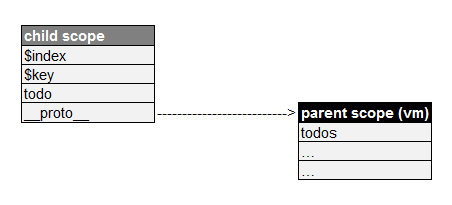
// file path: /src/directives/public/for.js create (value, alias, index, key) { // index是遍歷數組時的下標 // value是對應下標的數組元素 // alias = 'todo' // key是遍歷對象時的屬性名稱 ... var parentScope = this._scope || this.vm var scope = Object.create(parentScope) // 以parent scope為原型鏈創建child scope ... withoutConversion(() => { defineReactive(scope, alias, value) // 添加alias到child scope }) defineReactive(scope, '$index', index) // 添加$index到child scope ... var frag = this.factory.create(host, scope, this._frag) ... }detect change
到這里,基本上“初探”了一下List Rendering的過程,里面有很多概念沒有深入,打算放在后面結合其他使用這些概念的地方一起在分析,應該能體會到其巧妙的設計。
***舉兩個例子,回顧上面的內容
例一:
vm.todos[0].text = 'Learn JAVASCRIPT';
改變的是數組元素中text屬性,由于factory創建的fragment的v-text指令observe todo.text,因此這里直接由v-text指令更新對應li元素的TextNode內容。
例二:
vm.todos.push({text: 'Learn Vue Source Code'});增加了數組元素,v-for指令的watcher通知其做update,diff算法判斷新增了一個元素,于是創建scope,factory克隆template,創建新的fragment,append在#end-anchor的前面,fragment中的v-text指令observe新增元素的text屬性,將值更新到TextNode上。
感謝各位的閱讀,以上就是“怎么使用Vue.js中的List Rendering”的內容了,經過本文的學習后,相信大家對怎么使用Vue.js中的List Rendering這一問題有了更深刻的體會,具體使用情況還需要大家實踐驗證。這里是億速云,小編將為大家推送更多相關知識點的文章,歡迎關注!
免責聲明:本站發布的內容(圖片、視頻和文字)以原創、轉載和分享為主,文章觀點不代表本網站立場,如果涉及侵權請聯系站長郵箱:is@yisu.com進行舉報,并提供相關證據,一經查實,將立刻刪除涉嫌侵權內容。